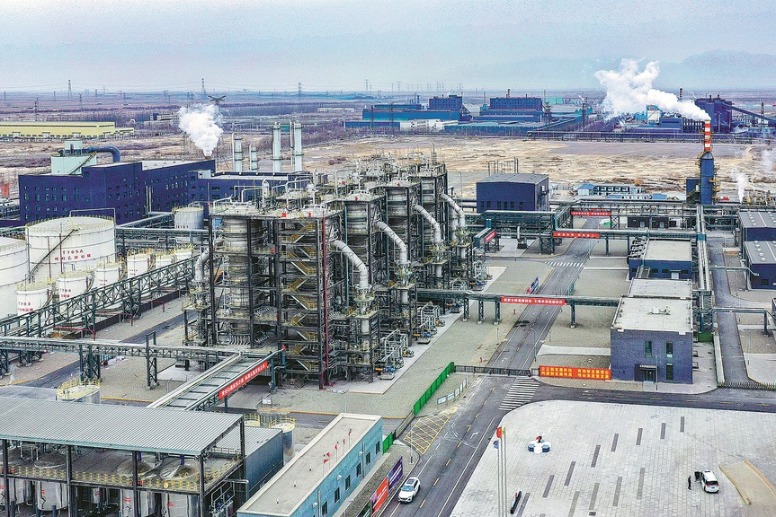Work in progress

More jobs, higher wages and a new focus on innovative technology are spearheading change in China's labor force
A new monthly measure of unemployment in China is being hailed as reliable and in line with international standards. It has also cast a spotlight on significant changes taking place within the workforce in recent years, as the unemployment rate falls to its lowest ever level and wages rise.
And it is not just that more people are getting jobs — they are getting better paid jobs.
In 2008, the average annual wage in China was 29,229 yuan ($4,600). In 2016, it reached 67,569 yuan, and by all accounts the increases have continued.
The monthly measure by the National Bureau of Statistics, based on ongoing surveys, found the unemployment rate in cities and towns was 5.1 percent in March.
Earlier employment figures were more difficult to track. The long-standing practice was to release a quarterly "urban registered jobless rate" that covered only those who had registered to participate in the survey. Estimates suggest that about half the workforce actually registered.
"The definition of the employed population and the unemployed population in China is consistent with the International Labour Organization standards. The investigation of the unemployment rate is of international comparability," said Ning Jizhe, head of the NBS.
Ning, who is also deputy director of the National Development and Reform Commission, said the unemployment rate is one of four major macroeconomic indicators. The other three are: the economic growth rate, the consumer price index, and the balance of international payments.
Sameer Khatiwada, an economist at the Asian Development Bank, is among those who welcome the availability of the monthly data.
"Previously the assumptions for China were based on the quarterly numbers, with more precise numbers being hard to access," said Khatiwada. "But with the figures now available on a monthly basis it gives us even clearer insights on the employment situation in the country, because we can track the fluctuations in closer detail.
"And because China's situation has an effect on the rest of the region, it should also help us with our outlook for other countries as well," he said.
China aims to keep the annual unemployment rate — as measured by the urban surveys — within 5.5 percent and the urban registered unemployment rate at 4.5 percent.
And there are indications that China's employment situation has not only remained stable but has actually improved over time. The new data suggests urban unemployment decreased by between 0.1 and 0.4 percent between the first quarter of 2017 and the first quarter of 2018.
In fact, unemployment could be viewed as less of an issue in China than in other developing countries or compared to the global average. The ILO said average unemployment in developing countries is 5.5 percent, a little lower than the 5.7 percent global average.
With the clearer view provided by the new data methodology, the government is making moves to further address the employment picture.
Trevor Yu, an associate professor at the Division of Strategy, Management and Organization at Nanyang Business School, noted that wage growth in China has eclipsed that of other countries like Singapore.
"I believe that this is more due to the fact that economic growth in China has also been higher than that of Singapore, which in turn can be attributed to the relative maturity of both economies," said Yu.
"Wages and employment rising in China is symptomatic of a Chinese economy that is still continuing to grow at a healthy rate, which according to official figures is still targeted at 6.5 percent for 2018."
Yu noted the effects of higher wages on international companies.
"First, their increasing manpower costs increase their cost of doing business in China. This may at first seem bad for China's competitiveness but, in the longer term, higher wages also mean that companies have a more productive, higher skilled labor pool to hire from," said Yu. "This would allow them to move up the value chain."
Now that the workers in the "world's factory" generally expect to have jobs, they will also expect to be paid more. And that expectation will likely have an impact on what it means to manufacture in China.
The country's industrial upgrading campaign calls for the production of more high-end goods that require significant intellectual property and greater innovation.
China has already started losing low-paying manufacturing jobs to other developing countries like Vietnam, Indonesia and Sri Lanka.
Queenie Leung, manager of a Hong Kong-based toy manufacturing company, said the higher wages have already led her company to shift manufacturing away from China.
"We moved our main manufacturing plant to Vietnam and it was the best decision we've ever made," said Leung, adding that her company's products require a lot of human assembly.
"The average (monthly) salary for a Chinese factory worker is about 3,000 yuan, while in Vietnam it is around 1,800 yuan," said Leung.
And it was not just the higher cost of manpower at home that led to the move abroad.
"The younger generation in China isn't that interested in working in factories anymore, and more mature workers also take longer to train. So we've actually had problems finding the right manpower as well," Leung said.
But such a move does not come without challenges. Leung said in Vietnam the company had to address language barriers, a lack of access to materials and a lesser productivity rate — all adding to the costs.
However, the toy maker still maintains a small factory in southern China for a number of reasons.
"We keep our factory there because most of our clients are in China. It's much easier to communicate with them by maintaining a presence there," Leung said.
"We also use our China factory for a lot of test runs. A lot of innovative manufacturing technology is actually coming from the mainland, so we are investing more in that and using it in our factory there too," she added.
Leung believes that technology, combined with higher wages and a shift in the workforce's ambitions, will lead to significant changes, including an increase in automation.
Khatiwada from the ADB said: "The rise of new technologies such as artificial intelligence and industrial robotics will, if headlines and many commentators are to be believed, destroy many of the jobs that made this transformation possible."
Though the rise in innovative technology will bolster advanced manufacturing, it remains to be seen whether this might eventually eat away at the employment rate.
"This might not be easy, with recent research suggesting that the manufacturing sector has lost power as an engine of job creation. Ever-increasing opportunities for automation enable the production of more goods without large workforces," said Khatiwada.
But, he added, the impact of automation and AI is not always clear cut. New manufacturing technologies may also create value even for low-paid and low-skill workers in the informal economy.
There are already examples in the region. "Take the case of Go-Jek, a motorbike service in Indonesia which has transformed Jakarta transport," Khatiwada said. "Digital technology has allowed Go-Jek drivers to expand into food packaging and food delivery, further boosting their productivity and earnings."
This could lead to a rise in tertiary industries providing opportunities lost from more traditional sources. There are already signs that an increased use of technology will unleash forces that offset job losses.
"In the Philippines' booming business process outsourcing sector, for example, robotic process automation might allow a customer service representative to field four calls simultaneously rather than one," said Khatiwada.
RPA could also spur the creation of jobs for better-trained financial and accounting professionals to handle the increased demand for services.
However, Khatiwada said workers would need extra training and will be in high demand.
"Some new jobs may call for skills that workers do not possess. People with weaker foundational skills best learned during childhood and adolescence could find themselves left behind. That's one reason why lifelong learning will be important for some workers," said Khatiwada.
- Number of foreign visits increases over threefold
- Shopping mall hosts 'space-out' competition in China
- Vlogger faces prison time, fines for killing wild boar in Beijing
- PBOC former vice-governor pleads guilty for bribery
- Shenzhou XVI crew members awarded for explorations
- China awards medals to Shenzhou-16 astronauts





































